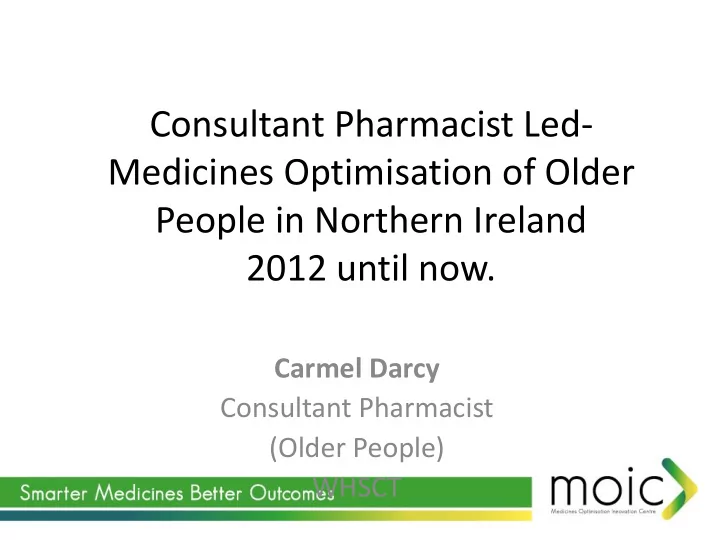

Consultant Pharmacist Led- Medicines Optimisation of Older People in Northern Ireland 2012 until now. Carmel Darcy Consultant Pharmacist (Older People) WHSCT
(Based on data available at the end of December 2017)
Consultant Pharmacists - 2012
Consultant Pharmacist Posts
Project Aim and Objectives Patient Drug and Healthcare Resource usage Implement, develop and Team working evaluate
Proposed Model 2012-2014
Core Outcomes • 453 patients case managed • 1100 clinical interventions • 2.5 interventions per patient • For every 1 drug prescribed 3 drugs were stopped • £153k pa healthcare resource usage • >3500 assessed for appropriateness using the MAI (Medication Appropriateness Index) • Statistically significant MAI reduction • Drug cost savings £68K pa
Reproducibility Test 2015-2016 • Intermediate Care - 4.4 clinical interventions • Care Homes – 2.5-3.6 (range 1 to 10) • Total MAI significantly dropped from first patient contact to completion of all pharmacist recommendations. • Intermediate Care - Total drug cost savings from primary care was 222k for both Trusts – Invest to save return is estimated at £2.19 - £3.54 per £1 invested. • Care Homes - Total drug cost savings from primary care was 262k for both Trusts • Invest to save return is estimated at £1.45 per £1 invested.
Medicines Optimisation • Donaldson report 2014 • Systems, Not Structures 2016 • MOQF 2016
MOOP Regional Roll Out 2017 NI Regional Innovations in Medicines Influence POLICY Group Medicines Optimisation for Older People (MOOP) Steering Group Trust MOOP Working Group Deliver at LOCAL Trust MOOP Teams LEVEL
Consultant Pharmacist-led landscape Medicines Optimisation for Older People Acute Care Patients IC Hospital Homes Own Home Acute Care @Home Adherence GP Practice Community Pharmacists Pharmacy
Adherence Model 2018
Preliminary findings – typical caseload • Data have been collected on 59 patients (40 female, 19 male, aged 81.0 ± 7.3 years). • Prior to referral, 33 patients were regarded as completely independent in managing their medicines. • 63% of patients were seen by the pharmacist within 7 days • Case management continued for an average of 25 days (Range = 2 to 65 days). • 156 clinical interventions were made with 82.7% Eadon self-graded ≥4 • A total of 320 adherence solutions recommended/provided (5.4 per patient) • There was a statistically significant reduction in the total number of drugs taken (p=0.014) and inappropriate prescribing (p<0.001) • An average drug cost saving of £128.41 per patient per annum has been realised.
Lessons from the journey • Develop models of care in line with strategic direction and policy. • Engage early with all potential stakeholders. • Fully understand the system and context you want to introduce a new service to i.e. process map • Identify potential service gaps and issues and then create an action plan in collaboration with all stakeholders
Lessons • Robustly evaluate with agreed relevant outcomes reflective of pharmacy input • React to data and refine models of care in response to the evidence • Disseminate at every opportunity i.e. share the learning • Stay consistent with proven care models and demonstrate reproducibility
Lessons • Don’t reinvent the wheel but know when to fix it • Standardise practice to enable reproducibility and roll out • Capture the patient ‘voice’ and service user experience
Consultant Pharmacist-Led Models General Practitioner & PBP Consultant Nursing and Community Pharmacist AHP Pharmacist & Patient Hospital Consultant
Clinical Vignette – Intermediate care • 84 year old female • PMH: TIA 2007, hypothyroid, Hypertension, Chronic kidney disease (CKD stage 4) • Refused package of care. • Lived with elderly sister. • PC: Fall – Right hip pain unable to weight bear • X-ray: No fracture, OA • Conservative management – transferred to intermediate care for further rehab.
Medicines on admission • Atorvastatin 10mg night • Amlodipine 10mg night • Bendroflumethiazide 2.5mg morning Dose reduction • Levothyroxine 50mcg morning • New Folic acid 5mg morning Polypharmacy • Clopidogrel 75mg morning • New Thaimine 100mg three times daily 12 New • Forceval one daily medicines New • Vitamin B co strong • Paracetamol 1g four times daily 23 doses • Omeprazole 20mg twice daily New • Ferrous fumarate 305mg twice daily NKDA
Pharmaceutical Case management • Medicines Reconciliation – On levothyroxine 75mcg mane not 50mcg • Medicines Review – Indication/duration/dose – Thiamine, Vitamin B Co, Forceval stopped – Omeprazole stopped – Drug-disease interaction – Bendroflumethiazide stopped (eGFR 34 CrCl 28 ) – Amlodipine stopped Systolic BP 112mmHg – Paracetamol reduced dose Low BMI/Frailty
Medicines Adherence • Patient-centred – Choice and preference considered • Access – No car, no telephone – friend/priest • Day to day management – ‘never forget to take them’ – Able to pop out of blisters – Good at taking medicines in the morning • Clinical – Appropriate medicines – Reduced pill burden (12 to 6 medicines)
Patient’s choice ‘want my medicine b oxes back’ ‘want to take them in the morning only’ ‘don’t want them d elivered’
Self-administration • Assessment • Medicines rationalised • Medicines reminder chart • Nurse - supervised administration • Patient – led ‘sister you did it wrong! I begin at the top of the strip and work down’
Continued case management • Discharged on 6 medicines • Communicated with GP and CP • Home visit at 4 weeks • Compliant with medicines – ‘liked the medicines reminder chart’ – ‘can I get a few more medicine cups?’ • Would like to only have to organise collection of medicines every 3 months
In sum Annie’s journey…. before, during and hopefully NOT after • Failed to get the right medicines • Exposed to avoidable risk from her medicines • Never given a choice about her medicines
Recommend
More recommend